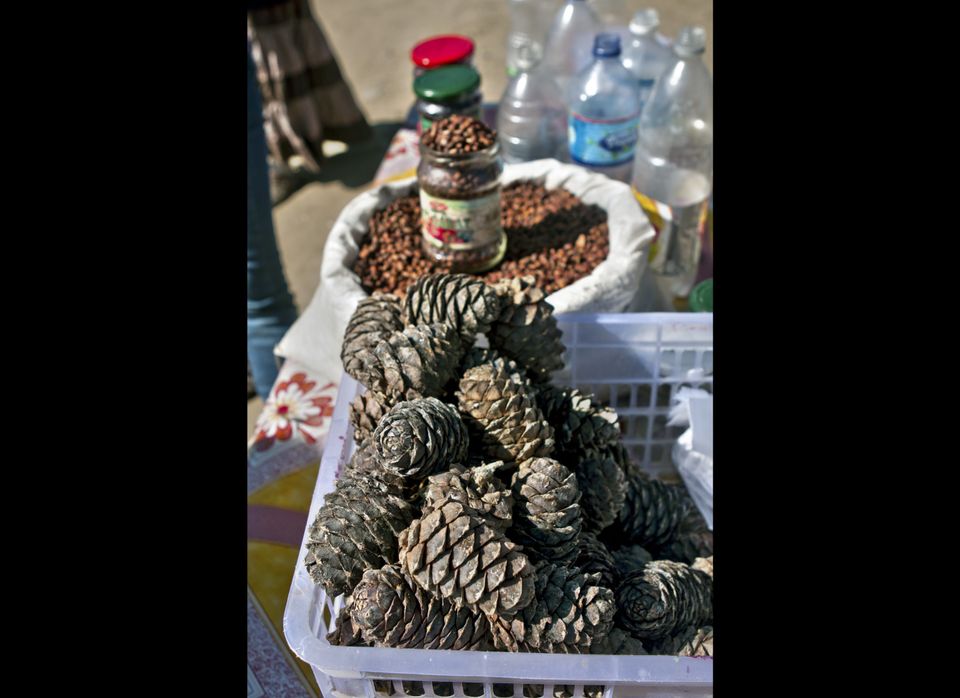As I am walking through the forest, my Mongolian friend, Baagi, throws up a bulky stick up into the branches of a pine tree. I stand cautiously back and look up to see two pinecones fall to the ground. We both run to the pinecones; they are as large as my fist. We are satisfied with our loot and immediately start peeling way to reveal fresh pine nuts. On this late spring day, my friends and I were hiking through the forests near of Manzushir, a former Buddhist monastery, located south of Ulaanbaatar.
Throughout the trek, regardless of how difficult the terrain is, the Mongolians in our hiking group are preoccupied with our hands and teeth working quickly to shell more pine nuts, as quickly as we can. The nut itself is no larger than the tip of a pinky, but it packs a powerful and addictive taste. The foreigners in our hiking group are unaccustomed to working so hard to consume a pine nut, and face a learning curve, as the technique to crack the shell and pull out the nut using your teeth is perfected only with practice. When I was younger, my grandfather would shell pine nuts for me. I would patiently collect them in my palm, to eat them all at once. As I got older, I learned how to shell them myself, but used a handy trick: when I would bite through the nut completely, I would throw it against the table, and the halves of the nut sometimes would fall out to my delight.
If there is a harvest, then you will find that the streets of the capital are a mine field of pine shells. On every busy street corner, there are vendors, selling the pine nuts in cups. One large cup is usually 2,000 MNT or a little more than a dollar. Pinecones as well as pine nuts with the shell are available for purchase. You will not however, find shelled pine nuts.
Mongolians eat pine nuts as a snack. There is no traditional food that incorporates the pine nut into a meal, unlike for instance, in Korea where the pine nuts are made into porridge or Italy where the pine nuts are used for pesto and in the United States, where pine nuts are often seen in salads. For Mongolians, the pine nut is not only a snack, but provides locals with much needed vitamins and mono-unsaturated fatty acids (among the many health benefits of pine nuts) as the local diet consists mainly of meat, starch, and dairy. The land is arid, and the temperatures are not hospitable to farming, the main reasons that constrain the Mongolian diet to mainly three food groups.
The pinecones of Mongolia are collected by groups of entrepreneurs, who trek to the mountains and forests on overnight trips to collect pinecones. Some pickers will even stay for the duration of the winter, for weeks at a time, picking off what is left from the summer harvest. The pickers will climb the trees and collect fallen pinecones, as well as use the force of logs to shake trees.
The cones then are sorted, or crushed by a machine to extract the nuts in the forest and brought to the market for sale. The pinecones are sold by the collectors themselves or sold on the black market at wholesale price for street vendors. At the moment, the going price is 4-6 USD a pound at the black market. There are also of course, groups of friends that will go and pick pine nuts as an outdoor excursion, with no intent to sell their findings. Interestingly enough, there is no established supermarket in the city that sells pine nuts. The street-vendors are the only source.
To learn more about this business, I sat with a young female street vendor who usually sits right across the street from my apartment with her son. The young woman, Ganaa, explained that this is actually her first time in the nut-trade. Her business involves her whole family. Her sister is selling nuts down the street, and her mom will sit with her for company. This particular year, Ganaa saw how her neighbors were clamoring about the strong harvest and how very active they were as street vendors. Ganaa's entrepreneurial momentum is propelled by the fact that she, at age 20, is the main breadwinner for her family of four: mother, sister, and son.
Ganaa and her family travel nearly over an hour from the outskirts of the city, from the ger district, by bus carrying boxes of pine nuts to sell for over 9 hours a day. The day is over when all of the nuts are sold. She sits on a busy street, however, away from the highest traffic areas nearby which include a large department store and a movie theatre. Her reasoning is that in fact, those areas are very competitive and are "territories" of other nut vendors. Her timid and quiet demeanor leads me to believe she is unwilling to fight for territory. Temperatures right now in Ulaanbaatar are in the single digits (celcius) during the day and hit below zero at night. The nut vendors are undoubtedly, still selling.
There are few street vendors in Ulaanbaatar with the exception of in season berry vendors and pine nut vendors. Beyond that, there are fruit stands, and some elderly people who sit with hard-boiled eggs, candies, and cigarettes. With that said, during the years when the nut harvest is strong, or existent at all (it is not every year there is a harvest), the city of Ulaanbaatar is undeniably cohesive: people of all walks of life and ages "самар цөмөөд cууж байгaa" or in English, are sitting and cracking pine nuts.
